
Because of the great importance of eye height, what you see depends very much on where you stand. So I'll consider a couple of different heights: one just inside the bottom of the duct, at 46 m height; the often-used height of 54 m, near the middle of the duct; and perhaps more to come.

The
transfer curve
shows that the slight
towering
is confined to a few minutes of arc above
the astronomical horizon. This raises the upper part of the image, which
therefore displays a slight
looming
effect, but is undistorted.
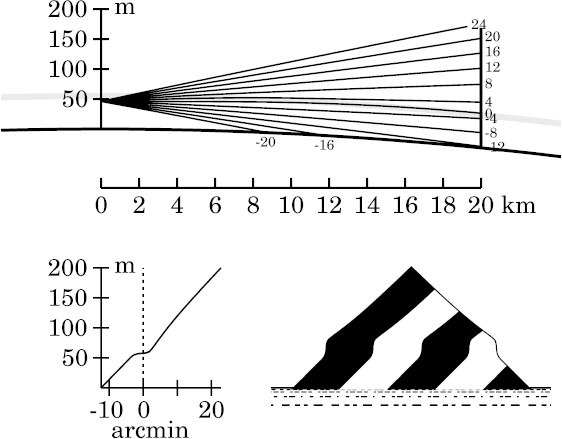
A slight
stooping
of the region immediately above the towered zone is
barely visible here. There is no mirage at 20 km range; but you can
see from the ray diagram that the horizon ray is bending down toward the
ray at −4′ altitude, so ray-crossing and mirage are produced at
slightly larger target distances.
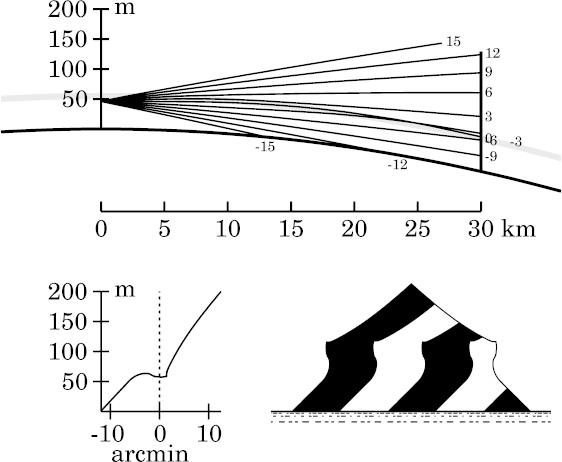
Notice that this mirage has two distinct parts: a strongly towered image in the strip centered on the horizon ray, and a less-towered part in the zone immediately below that. This lower part of the mirage is clearly Wegener's Nachspiegelung, because the strongly-towered zone corresponds to Wegener's miraging strip.
The upper, strongly-towered part of the mirage is produced by rays near the horizon ray, all of which are focused near the same height on the target. They all are ducted, and reach the target within the inversion.
The lower,
Nachspiegelung
part of the mirage is due to rays near the −3′ ray.
Like it, they pass entirely through the inversion (without ducting), and
have different path lengths within it, striking the target above
the inversion layer.

This case is discussed in detail on the page dealing with the effects of eye height. As mentioned there, the curvature of the sides of Wegener's strip is due to his periodicity effect, although it is weaker here than for his toy model at the same eye height and target distance. So, while the toy model already produced an erect image in the miraged strip at this geometry, we see only a distorted (curved) inverted image here, in the zigzag model.
However, the effect still works; it just takes a somewhat greater target
range to produce focusing, and eventually image erection — as the
next two cases demonstrate.
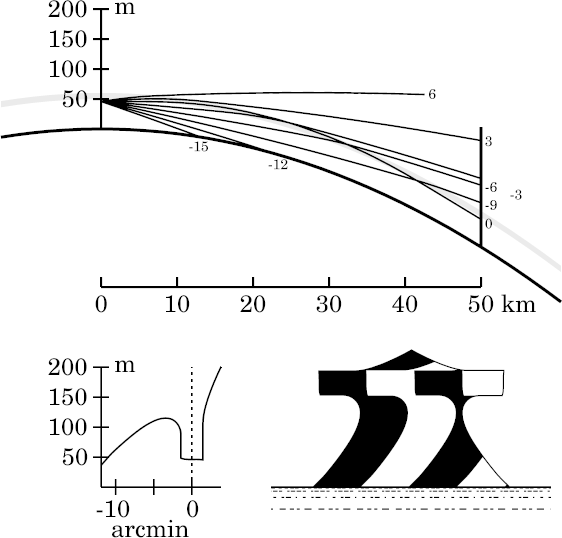
The increasing range produces increased stooping of the top section of the
image, above Wegener's strip.
The lower part of the image is disappearing below the apparent horizon: we
have already lost the rightmost black stripe at the bottom right of the
image.

Of course, the zigzag model produces a much stronger
Nachspiegelung
below the strip. And the greater range here has lowered all the erect
parts outside the strip: now, even the white stripe at the
lower right corner has almost sunk below the apparent horizon.
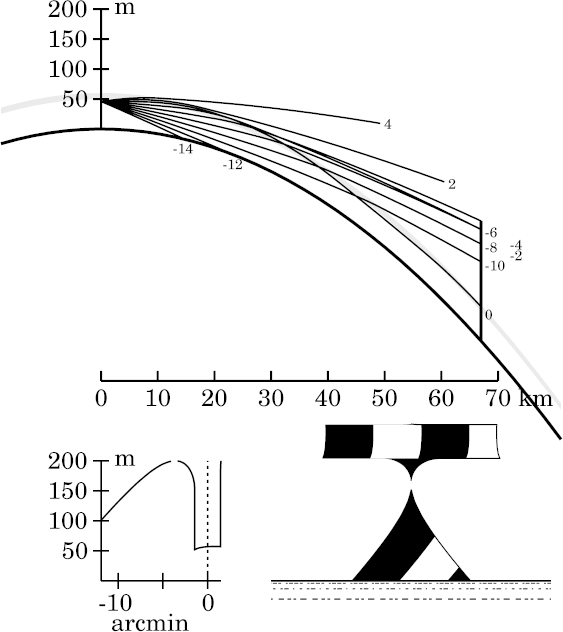
The
periodicity effect
is continuing to modify the mirage in Wegener's
strip:
once again, its towering is increasing, as we approach another image
inversion.
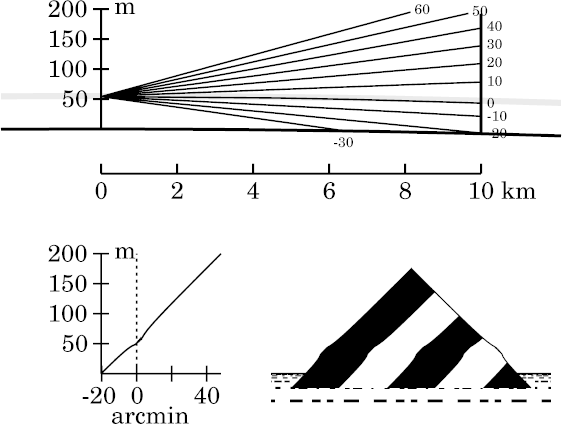
As you might expect, the small distortion near the astronomical horizon is a little bigger for this observer, near the middle of the thermal inversion, than for the one at 46 m height.
Qualitatively, what we see here, at 54 m, is similar to what was seen
at 46 m:
slight towering near and above the horizon ray, and slight looming in the
upper part of the image.
But the effects are too small to make out clearly at this short range.
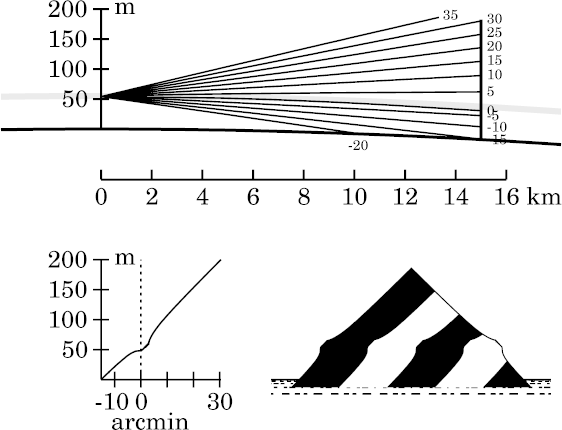
Below this undistorted zone, the rays leave the inversion layer before reaching the target — the more so, the farther they are below the astronomical horizon. So the looming decreases rapidly with decreasing altitude, producing a vertically stretched (towered) zone.
Above the undistorted zone, the same effect is at work, but in
reverse. Again the looming falls of with increasing distance from the
horizon, but here that's the direction of increasing altitude.
So this region is vertically compressed (i.e., stooped).
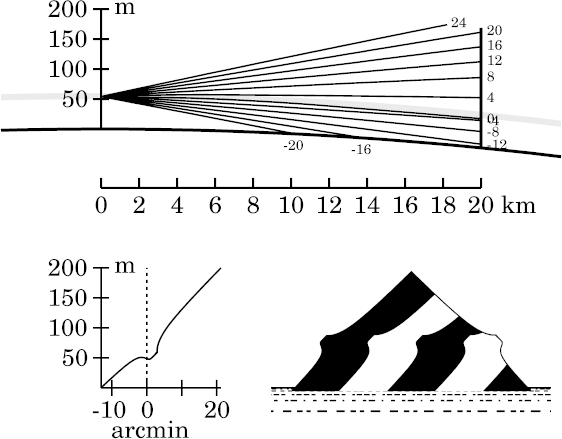
The three image zones are still quite prominent: the short, undistorted section (loomed), sandwiched between the stretched — here, miraged — lower zone and the squashed (stooped) one above it.
Because of the longer path in the thermal inversion, the horizon ray
actually leaves the bottom of the inversion just before reaching the
target; so the boundary between the lower two zones has now moved up to
just above the horizon. Thus, the mirage
is gradually eating into the undistorted zone from below, as the target
distance increases.
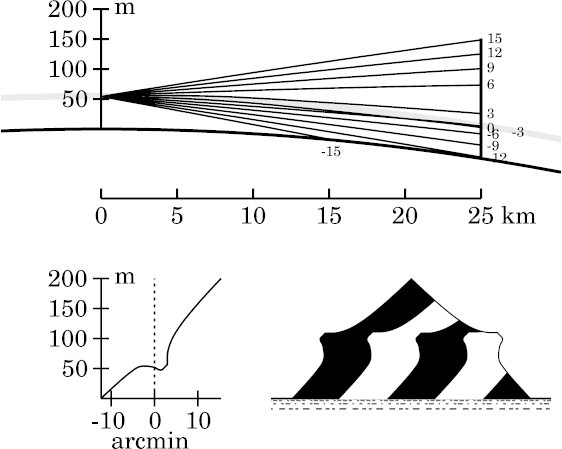
Finally, the stooping of the upper zone has increased, while the
apparent altitude of the target's apex has decreased with distance;
so the stooping is now evident in the whole upper part of the target
(notice that its apex angle is now obviously obtuse).

Above the projecting corner, the bottom of the stooped zone is becoming the flat upper edge of Wegener's miraging strip. This edge is a discontinuity between trapped (ducted) rays and those that pass freely through the inversion.
Despite the increasing complexity, there are still only three images, at
most, of target points. This is a classic 3-image mirage; but if the
target had been shorter, so than none of it projected above Wegener's
strip, it would be a textbook 2-image superior mirage.

Notice that the undistorted zone that was formerly visible above the
miraged zone has disappeared entirely here. It has been replaced by a
sharp corner, where the top edge of Wegener's
strip
is now prominent, just below the very stooped apex of the target.
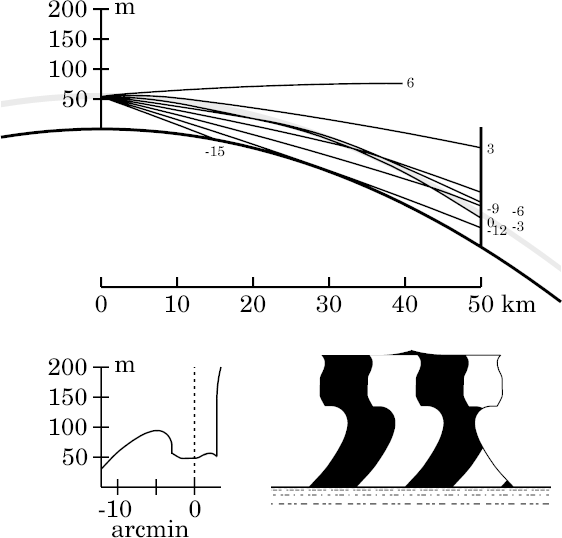
The upper half of the strip contains a prominent erect image, due to ray-crossings near 40 km. The entire strip is filled with highly stretched, multiple images. This would probably be considered a Fata Morgana mirage in the real world.
Only a trace of the extremely stooped apex of the target remains visible.

The top of the target, above Wegener's strip, has practically disappeared.
Copyright © 2009, 2012 Andrew T. Young
or the
introduction to all mirage simulations
or the
main mirage page
or the
GF home page
or the website overview page